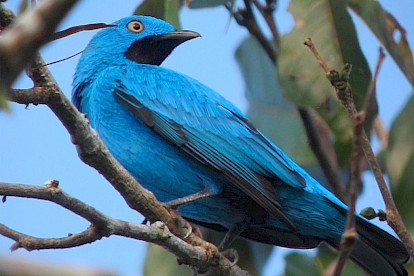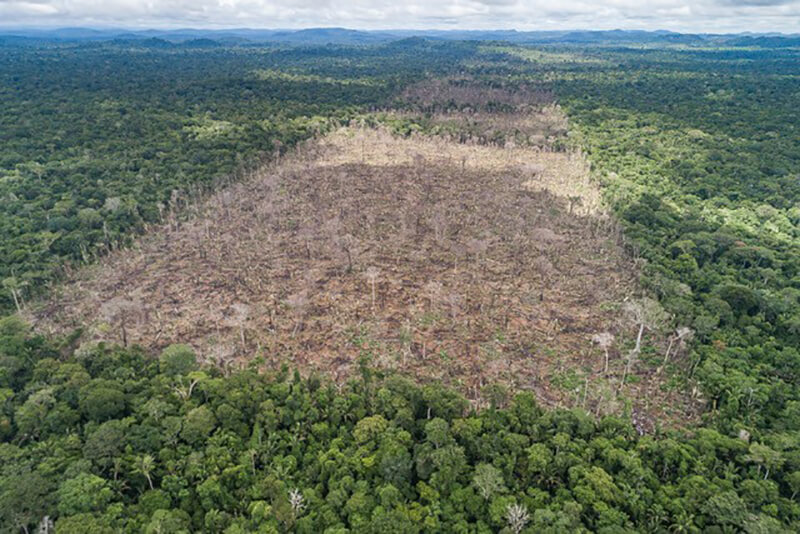Ending Amazon deforestation a top priority on Colombian minister’s D.C. visit
Colombia is courting other governments and conservation organizations for support in tackling Amazonian deforestation bringing about what it describes as one of the most ambitious emissions reduction goals in the world.
Carlos Eduardo Correa, the country’s minister of environment and sustainable development, visited Washington, D.C., from July 14 to 16, where he met with members of Congress, representatives of the Environmental Protection Agency (EPA), and nonprofit organizations such as WWF, Conservation International and the Amazon Conservation Team, among others. Correa discussed with them the priorities of the Colombian environment and sustainability sector.
Correa made the United States his first international destination in the context of the COVID-19 pandemic, thanks to the solid political bonds and common environmental interests between the two countries.
 According to Correa, with its return to the Paris Agreement, the U.S. government has a crucial climate plan aligned with Colombia’s priorities.
According to Correa, with its return to the Paris Agreement, the U.S. government has a crucial climate plan aligned with Colombia’s priorities.
“We are talking about the new globalization being the globalization of the climate. The United States, with its return to the Paris Agreement, is promoting global and regional discussions on the environment, in which Colombia has leadership on different fronts,” Correa told Mongabay in a telephone interview.
In this scenario, he added, one of the common interests and the highest priority is the fight against deforestation. “All the organizations we visited are working along the same lines,” Correa said.
“Colombia has made great efforts against deforestation, and this year we already have a 30% reduction in the first quarter compared to 2020. This has been thanks to the restoration of more than 300,000 hectares [741,000 acres] of forest and our ambitious plan of planting 180 million trees by 2022,” he added.
Correa announced the decline in the deforestation rate at the beginning of July during a presentation of the annual deforestation report, carried out by the Institute of Hydrology, Meteorology and Environmental Studies (Ideam), the meteorological authority of Colombia.
Correa, together with Fernando Cruz, the vice minister for policy and environmental standardization, said that, in the first quarter of 2020, 62,200 hectares (153,700 acres) were deforested in the Amazonian departments of Meta, Caquetá and Guaviare. But in the same period in 2021, the number fell to 41,600 hectares (102,800 acres), or down by a third.
In an interview with national newspaper El Tiempo, Cruz attributed the decline in part to more rains, and hence less risk of fire, brought by the La Niña weather event at the start of this year. He also credited Operation Artemisa, a series of raids by the military against illegal loggers.
However, Correa said that overall 2020 was a particularly negative year for Colombian forests.
That year, the country lost 171,685 hectares (424,243 acres) of forest, with the Amazon the most affected region: it lost 109,302 hectares (270,091 acres) of forest, an increase of 11% from the previous year.
Correa said the progress seen in 2021 was possible thanks to work with communities, social investment, payments for environmental services, natural conservation contracts, and the strengthening of green businesses.
“We are oriented to the energy transition and sustainable mobility. And this work is also aligned with the international organizations I met. They have all the will to continue working in Colombia, as they have already been doing for many years,” Correa told Mongabay.
The minister highlighted the meeting he held, on his last day in Washington, with Jonathan Pershing, the senior adviser to the U.S. special presidential envoy for climate, John Kerry. In that meeting, Correa said, they agreed on strengthening actions to protect forests in the Colombian Amazon.
An eye on COP26
Correa also told Mongabay that several of the points discussed with Pershing remain on the agenda for meetings in London with environment ministers from other countries. This international tour is part of the run-up to the 26th Conference of the Parties (COP26) to the United Nations Framework Convention on Climate Change (UNFCCC), which will take place from Oct. 31 to Nov. 12 in Glasgow, Scotland.
“Our climate plans make us think not only in the year 2022, which is when the government of Colombian President Iván Duque ends, but in medium- and long-term objectives: achieving the 51% reduction of greenhouse gas emissions and reaching zero deforestation by 2030, and becoming carbon neutral by 2050,” Correa said.
He described Colombia’s emissions reduction target as one of the most ambitious in the world. To achieve it, his ministry is implementing mitigation and adaptation measures and plans for ecological restoration and conservation, sustainable mobility, and environmental education programs, among others.
Correa said it would be essential to have economic support through international cooperation and resources from the national and local governments to accomplish these objectives. He said they would also use royalties from extractive industries to finance these efforts. In Colombia, oil and mining companies pay a percentage to the government for exploiting non-renewable natural resources.
“Some of the organizations we met, such as WWF, Conservation International, Wildlife Conservation Society and USAID, among others, are cooperating with Colombia on these fronts. What we want now is for these financing schemes to be larger and for other NGOs and nonprofit organizations to come to Colombia to join these initiatives,” Correa told Mongabay.
“Now, we are working on estimating the costs associated with the implementation of the Nationally Determined Contributions [NDC] both for our adaptation goals and for our mitigation measures. At the end of this year, we will have an estimate of the costs. We are also working on developing strategies for the consolidation of instruments and mechanisms for financing the NDC,” Correa said.
You can return to the main Market News page, or press the Back button on your browser.


